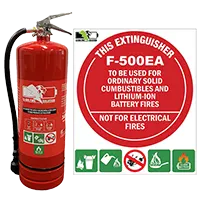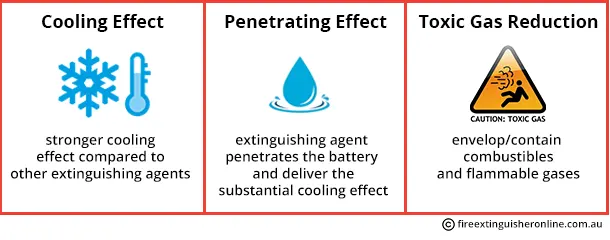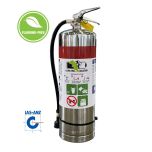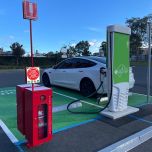 F-500 Li-Ion Fire Extinguishers are a great multi purpose stainless steel fire extinguisher that deliver a solid level of fire protection and are ideal for Lithium Ion Battery Fire and Class A fire. They are the first agent proven to extinguish lithium-ion (Li-Ion) batteries, without reignition. They are non-corrosive, non-toxic, non-hazardous and fully biodegradable. Here’s a guide on how to identify them, how they work and when to use them safely:
F-500 Li-Ion Fire Extinguishers are a great multi purpose stainless steel fire extinguisher that deliver a solid level of fire protection and are ideal for Lithium Ion Battery Fire and Class A fire. They are the first agent proven to extinguish lithium-ion (Li-Ion) batteries, without reignition. They are non-corrosive, non-toxic, non-hazardous and fully biodegradable. Here’s a guide on how to identify them, how they work and when to use them safely:
F-500 (Lithium Ion Battery fire) extinguisher colour:
All new fire extinguishers in Australia are painted with a rich red colour, which is referred to as Signal Red.
A 4L Li-Ion extinguisher has a red body and do not come with a band colour. The 9L version is silver to differentiate it from the rest.
F-500 (Lithium Ion Battery fire) extinguisher sizes:
Available in 2 portable Sizes: 4L & 9L. And in 2 mobile sizes: 45L and 90L
How does a F-500 (Lithium Ion Battery Fire) extinguisher work?
Each type of extinguisher works by attempting to remove one of the elements (heat, oxygen, fuel) that are needed for a fire to flourish. Lithium-ion batteries burn at an extremely high temperature ( > 1000°C) and do not require oxygen to burn. The F-500 Li-Ion solution particles within the mist penetrate the surface of the burning fuel to quickly remove the heat and stop the reaction of the electrode material with other components of the battery, bringing the fire under control.

Here is a video about Lithium Ion Batteries fire testing: The 9L F-500 Fire Extinguisher has been tested on a 4.8KWh Lithium-Ion battery fire.
When to use a F-500 (Lithium Ion Battery fire) extinguisher?
F-500 (Lithium Ion Battery Fire) Extinguishers are mainly used for Lithium Ion Fires. They are rated for Class A fires, but they can also put out Class B and F fires.
Lithium Ion Battery Fire extinguishers:
- Lithium Ion Battery Fires
- Class A – Normal combustible materials such as wood, paper, cloth, plastic or rubber products
- Class B – Fires involving combustible flammable liquids such as petrol, oil paint and solvents - not rated, limited efficiency
- Class F – Fires where the ignition source contains cooking oils or fats - not rated, limited efficiency

F-500 (Lithium Ion Battery fire) extinguisher DO NOT USE ON:
F-500 (Lithium Ion Battery extinguishers) should not be used on fires involving flammable metals, electrical fires (risk of danger as water based) and also are not suitable for use on flammable gases.
Where to use a Lithium Ion Battery fire extinguisher?
Lithium Ion Battery extinguishers are recommended to be used indoors and outdoors, from data centres, EV charging stations to wind farms, Tesla showrooms, industrial workplace and electrical vehicles. They are also to be used for smart phones, laptops, solar panels.
How to use a F-500 (Lithium Ion Battery Fire) Extinguisher?
MAKE SURE YOU HAVE DISCONNECTED THE BATTERY FROM ITS CHARGER / POWER POINT. Or cut the power to your home. F-500s are water based and can conduct electricity.
Knowing how to operate a Lithium Ion Battery fire extinguisher could save your life in an emergency.
The key to putting out a fire with a carbon dioxide extinguisher is to use the PASS strategy: Pull the pin, Aim the hose towards the base of the fire, Squeeze the lever, and Sweep the hose.
Remember: Fires double in size every 60 seconds so use a fire extinguisher for small, contained fires only. Leave immediately if you're unable to extinguish the fire and call 000.
F-500 (Lithium Ion Battery fire) extinguisher Service & Maintenance:
In an Australian business environment, all Lithium Ion Battery extinguishers must undergo hydrostatic testing and recharge every five years. All Lithium Ion Battery fire extinguishers must carry a maintenance tag that shows their last inspection date, and must be serviced every 6 months. Once your extinguisher has been discharged, it must be pressure tested & recharged, or replaced.
At home, Lithium Ion Battery fire extinguishers can last up to 10 years but you need to check them regularly (we recommend twice a year to check the following: pressure is at the recommended level, nozzle or hose are not obstructed, pin and tamper seal is intact, no dents, leaks, rust, chemical deposits and other signs of wear).
How to clean up after a Lithium Ion Battery fire extinguisher?
Water-based cleanup methods are the prefered method.
- Using large amounts of water and rinse the area.
- Use a damp cloth to clean any leftover residue.
- Place all The F-500 Li-Ion solution into a bag, seal and then dispose of it in the normal waste bin.
F-500 (Lithium Ion Battery fire) extinguisher discharge effects to be aware of:
- F-500 Li-Ion solution on your skin – rinse with water.
- Disposal in drain systems – The F-500 Li-Ion solution is safe to discharge down normal drains;
How to Refill & Recharge a F-500 (Lithium Ion Battery fire) extinguisher:
In Australia, F-500 Fire extinguishers must be discharged and recharged every 5 Years. The refill process should be done by a trained professional (handling of pressurized chemicals). If it is not done adequately, the extinguisher could malfunction in case of an emergency.
Here are simplified steps of the F-500 extinguisher refill process:
- Empty and depressurize the extinguisher (remove hose, valve assembly, clean...)
- Fill the cylinder with the amount of chemical specified on the label
- Re-Pressurize the extinguisher (check for leaks)
- Reconnect hose and ring pin
- Weigh the fully assembled fire extinguisher
F-500 (Lithium Ion Battery fire) extinguisher Disposal & Recycling:
F-500 Fire extinguishers are classified as a dangerous good and can not be disposed of at your household waste collection and/or curb-side collection. So how do you safely dispose of a used, expired but unused or empty Lithium Ion battery fire extinguisher?
Please check this article to dispose or recycle your old F-500 (Lithium Ion Battery Fire) Extinguisher: https://www.fireextinguisheronline.com.au/fire-extinguisher-recycling
You can also contact your local fire department and enquire if you can drop those off at the firehouse to dispose of them (only for expired but full or partially filled fire extinguishers). And you can contact your local council.



